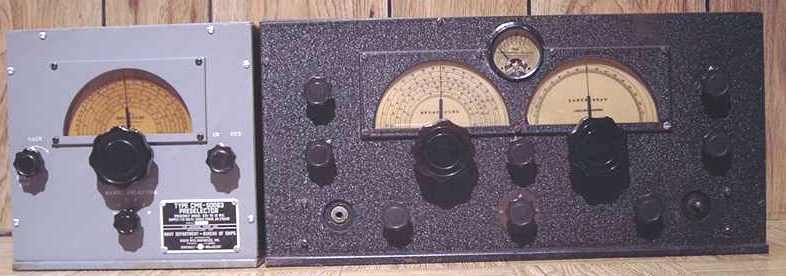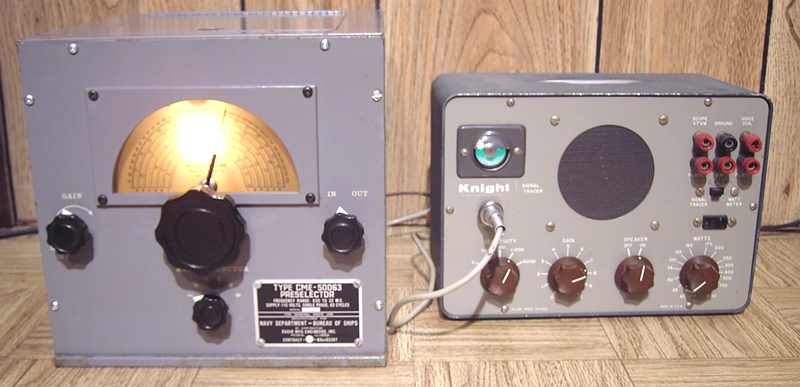
Radio Manufacturing Engineers (RME) DB-20 preselector

Introduced in 1936, it was common to see the DB-20 teamed up with the RME-69, typically in the same black wrinkle paint. However, the DB-20 was also used with a variety of other ham and shortwave receivers. For example the cover of the April 1946 Radio News magazine shows Bill Shaw W9UIG as among the first hams back on the air in 1946. The cover photo shows his receiver, a Hammarlund HQ-120 connected to a DB-20 preselector.
It was during World War II that the DB-20 really came into its own. Many, including this unit, were built for the U.S. Navy. Why? The Navy was concerned that enemy subs and ships could hear the local oscillator from on-board superheterodyne sets and home in with direction finders. The DB-20 preselector placed three tuned circuits including two active stages between the antenna and the receiver, thereby further isolating the antenna from a superhet's local oscillator/ converter stage. The Navy nomenclature tag shows this to be Type CME-50063, the Navy designation for the DB-20. This example is serial number 160. The Navy CME-50063 was produced in both black wrinkle and the Navy gray of this example.
See also the later DB-22A , which is a very similar device that matches the cosmetic design of the later RME-45 .

Repairs
This set had been modified with added SO-239 and BNC connectors for antenna input and output to receiver. Since those are handy coax connectors and the modification was well done, I left the set as changed. A couple of capacitors had been changed by the previous owner. After safety checks, the set powered up properly. I connected an antenna to the input connector and a signal tracer with diode probe to the output. I found it working partially on a couple of bands and was dead on others. It would also break into noise that I determined to be feedback at some settings of the variable cap.
I traced the noise problem to poor ground connections on the rotor of the variable cap. Cleaning with deoxit and working the cap solved that problem. The other problem with several of the bands turned out to be an intermittent connection on the bandswitch. A contact on the output section was not quite makng a connection. The spring contact was very difficult to get at. Cleaning did not help. The spring flex in the contact was weak and the moving portion of the switch was not quite level. No adjustment would permanently fix the problem. I had no desire to try to remove the bandswitch to replace the contact. Since the contact was near a metal divider/ shield, I took a small piece of hospital tubing, heated the end with a solder gun to make it flat and wedged the piece between the contact and the shield giving it enough additional spring action to solve the problem.
Alignment
The Navy manual for the DB-20 is on BAMA (see my home page for a link). I followed the alignment procedure and tweaked each trimmer as needed using the signal tracer for audio output. Alignment really brought the unit to life.
Preselector + signal tracer = TRF receiver
With two stages of RF amplification and three tuned circuits connected to a decent antenna, the DB-20 was fun for tuning broadcast and shortwave stations directly to a signal tracer which is essentaily an untuned crystal set with an audio amplifier and speaker. Selectivity was very good for the weaker stations and rather broad for more powerful stations. Of course, when used with a regular receiver, the RF gain on the preselector would not be turned up as high as with an amplified crystal set. An RME DB-20 working properly, when teamed up with a decent receiver, makes for very sensitive reception and much-reduced image ratio with a single conversion receiver.
A United Electronics Laboratories AM radio chassis was the previous item on the bench.